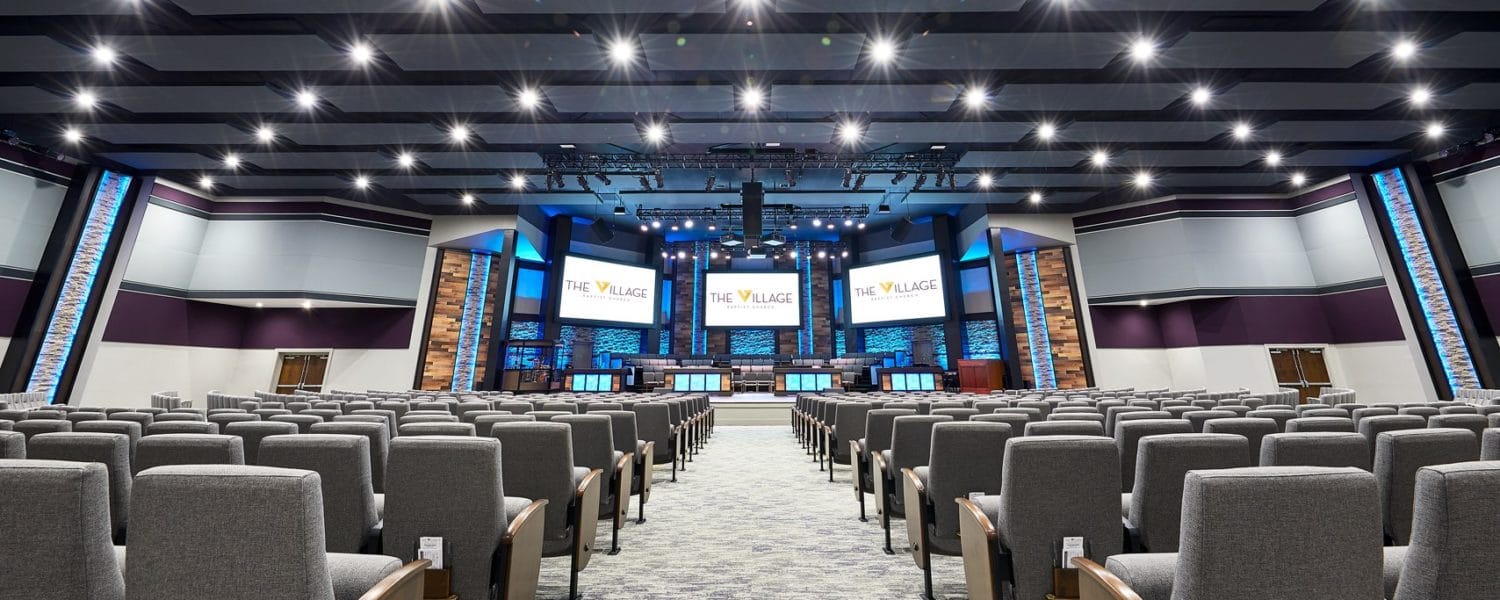By Donnie Brawner
Seating can be of the most contentious topics for a church. The debate is typically between those who want to hold onto their traditional pews and those who want a more modern solution. This article will address what’s often overlooked when deciding on seating for your church.
When discussing seating, the conversation should be about more than just aesthetics or tradition. Here are the two critical issues:
- Do first-time guests feel welcome and comfortable?
- Does the entire room foster engagement for the worship and teaching?
Modern church renovations must consider everything from interior design to audio, video, and lighting, acoustics, and of course, seating. All of these elements work together in creating an engaging, multi-generational environment. Not all benefits of different seating options are readily apparent.
Fixed Auditorium Seating Increases Fellowship
The first benefit of fixed seating is an increase of fellowship both before and after services. With standard pew seating, the people in the pews have to get up, empty into the aisles and make their way to the exit because there is no room to pass each other in the row. Many churches don’t have adequate gathering space, and, therefore, there is less opportunity for conversations and fellowship when everyone heads for the doors immediately.
Fixed auditorium seating widens the aisle. When you stand up, the seat bottom folds up, allowing space for people to pass. This additional space allows more people to remain in the auditorium and fellowship after the service ends.
Improve Engagement
The next benefit of fixed seating is increased engagement during the service. A comfortable seat allows parishioners, who are seated for the majority of a service, to stay focused on the message, not fidgeting to get comfortable in a seat or feeling awkward about sitting too close to their neighbor.
Both auditorium seats and individual modular seating create a more defined seating arrangement that ensures the appropriate distance between people. The proper seating can eliminate both of these distractions and keep attention on the platform.
First-Time Guest Experience
A significant concern for many churches is attracting millennials and the unchurched. It is a fact that the majority of younger families and people new to church appreciate the appearance, comfort, and flexibility of both auditorium and modular seating over pews. If you want to modernize your space, fixed auditorium and modular seating provide a very nice, modern look that immediately updates a room.
Auditorium seating design has come a long way over the last several years and is very comfortable for long periods – for all ages. Fixed and modular seating also allows an auditorium to feel more intimate by allowing customization of your seating arrangement.
Changing the seating layout can create more room in the back or add more aisle space, making it feel more intimate. Seating optimization should be an essential part of the equation since all churches should be focusing on improving the first-time guest experience.
More Capacity
While it’s not as much about the capacity as it is the seating efficiency, indeed, you can typically increase capacity by 15 to 20 percent with a fixed auditorium or modular seating over pews. Because individuals choose how close to sit in pews, people tend to spread out and fill the bench with purses and coats. Despite receiving less seat bottom space, congregants feel more comfortable in a modern seat with armrests.
Comfort That Can’t Be Beat
Most of today’s auditorium seats offer ergonomic comfort, with seats featuring a contour shape as well as lumbar support. Most modern chairs have over 4 inches of foam at critical pressure points. Pews only have 2 inches of foam. Something that also gets missed is that it’s easier for seniors to get up from the seat with armrests.
Options to Customize Your Space
Purchasing auditorium seating is like buying a new car. There are so many options: stationary arms, fixed arms, flip-up arms, wooden backs, upholstered backs, poly backs, various aisle panels, book racks, communion holders, cup holders, seat and row IDs, and even aisle lighting.
Like features of a car, these options allow you to customize your seating to fit your facility’s needs, tie into the interior design and the overall experience of the space. It is essential to consider your goals for the room when choosing seating options.
Modular Seating Offers Ultimate Flexibility
If you have a flat floor, it’s hard to beat the flexibility provided by modular, stackable seating. In this situation, any seat in the building is a handicapped seating option.
Brides can have their center aisle on Saturday, and there can be right and left aisles on Sunday. You can bring in round tables, move the chairs out, stack them to have an open space, or spread them out more than usual for social distancing. Stackable chairs range from very inexpensive metal chairs to nice, high-end, wooden stackable chairs that look at home in the nicest of spaces.
Lastly, keep in mind that changes to your seating style could impact the capacity of the space and, therefore, impact exits, bathroom counts, parking, and so on. It is crucial that if you consider making changes to your seating, you have a design firm or architect look into this to determine layouts and parameters.
While the debate around seating can be heavy, the benefits of fixed auditorium and modular seating extend beyond just aesthetics, impacting everything from interpersonal connection to comfort of first-time guests. The critics are typically the biggest believers when it’s all said and done.
Donnie Brawner is the owner/chief executive officer of Paragon 360. For over 20 years, Paragon 360 has been involved in building and renovating churches of all sizes and denominations nationwide, www.paragon360.com.














